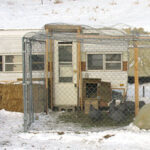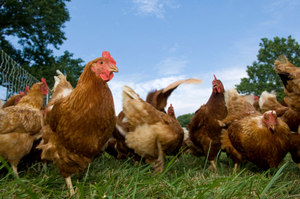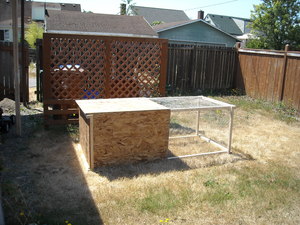With the economy still in trouble, many normal and sane people have decided to raise some chickens in their back yard. Once you’ve got the chickens and the coop, you need some chicken nesting boxes.
Hens need a little hide-away where they can lay their eggs. Providing your girls with a specific place to deposit their eggs makes your job easier. Nobody likes an egg hunt every day, plus it keeps the eggs safer.
There are plenty of poultry catalogs or farm stores that offer a two hole metal box for a whopping $165. But don’t panic yet, you can build your own nesting boxes from scraps of wood or even recycle some household items if you “think outside the box.
Before you get started, establish your criteria:
How many chicken nesting boxes will you need? You do not need a nest for each bird; because the hens don’t sleep in the boxes. They just go there to lay eggs. One box for every four chickens is sufficient.
How big should your chicken nesting boxes be? That depends on the breed of chickens you have. Bantams only need a box that is 10″ high by 12″ wide and 10″ deep. A bigger chicken (like a Leghorn or a Rhode Island Red) needs a box 12″ wide by 14″ high by 12″ deep. As a general rule, it is better for the nesting boxes to be a little too big than not big enough. The space needed is just a little bit bigger than your chicken when she’s all hunkered down on the nest.
What materials should you make your chicken nesting boxes out of? It is imperative that you use a material that is easy to clean and sterilize. Metal and plastic can be sanitized, bleached and scrubbed. They don’t absorb chicken feces and they don’t absorb whatever product you used to clean them. However, wooden boxes are convenient and easier to fabricate. I don’t recommend using cardboard boxes.
What else can be used for a chicken nesting box? You can use a big plastic salad bowl that you can get at a dollar store for – you guessed it — $1. You can use recycled plastic milk crates. You can even use metal roasting pans, although that would be quite ironic. You might have to adapt the bowls or crates or pans, by cutting down the front so the chickens can get in and out easily. Whether you’re making a box from scratch or recycling something else, try to leave a 4″ sill across the front to keep the eggs from rolling out.
You got the chicken nesting boxes, now what do you fill it with? While many of us chicken lovers like to assign human attributes to our feathered friends, they really aren’t very picky at all. Whatever you use as padding to protect the hen fruit as it’s deposited, make sure it’s not toxic and can be easily removed and replaced. Some materials you might consider are hay, straw, wood chips, shredded paper and saw dust. If you use grass clippings please make sure they weren’t chemically treated in any way. Some of the commercial supply houses as well as good farm and feed stores carry rubber mats that fit in the bottom of the chicken nesting box. They cost about $5 each but will last forever and are very easy to clean.
How to keep the chicken poop out of your chicken nesting boxes? Chickens like to roost. It’s in their nature, and you can’t fight it. When they are not on the nest, chickens will poop wherever and whenever they want. So, either locate your box out of range of any roosts or put a roof on it. That could be as simple as putting a shelf over the nests. If you’re building a chicken nesting box from scratch, pitch the roof at a 45 degree angle to discourage your girls from sitting up there.
Where to locate your chicken nesting boxes? Place the boxes in a dark corner and out of the way of other chicken traffic. You want to discourage your chickens from doing anything but laying eggs in their chicken nesting box. Some chicken folks just set their box on the ground or floor in the coop. Others recommend attaching it 18″-20″ up off the ground. However, if you intend to raise the box up, start it out on the ground, until your girls figure out what’s expected of them. You can install a perch just below the entrance for the hens to land on as they enter and exit the chicken nesting box.
Now that you’ve provided your ladies with a cozy little place to lay their eggs, it’s up to you to check it daily to collect the eggs. It’s important to establish a regular cleaning and disinfecting routine. I’ve always found it easier and cheaper to maintain an item rather than repair or replace it. Your chickens will thank you with contented clucks and fresh tasty eggs.





